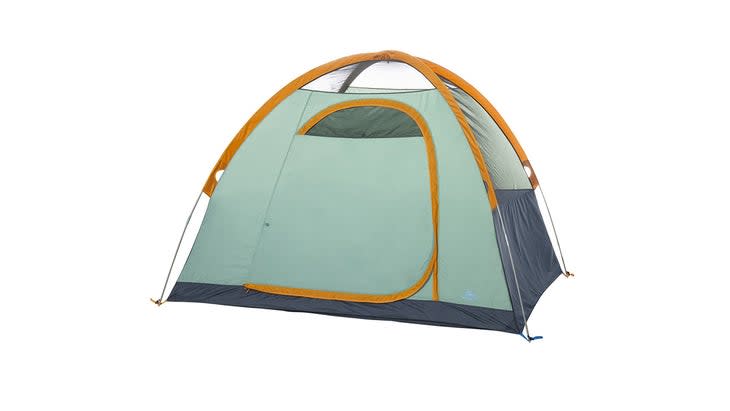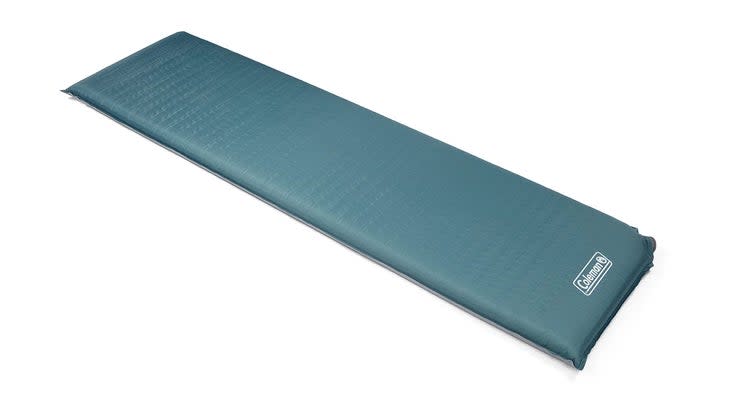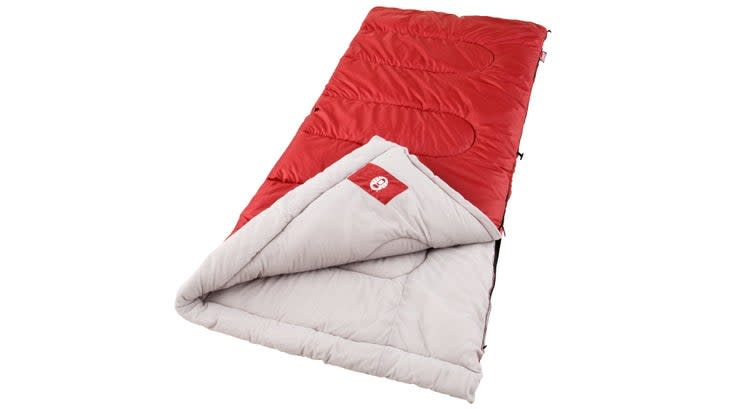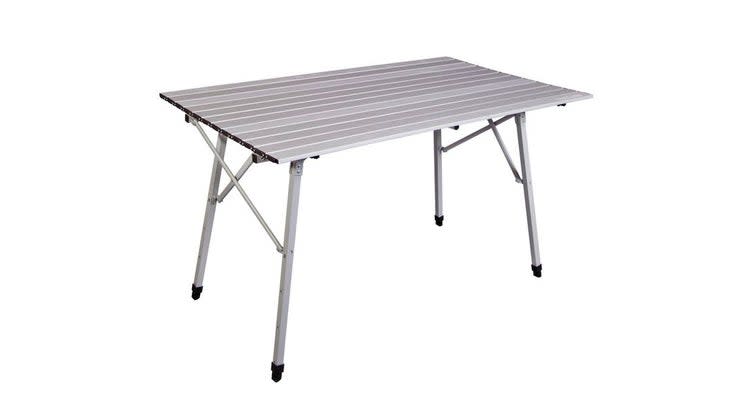7 Car Camping Must-Haves
This article originally appeared on Outside
Planning on camping this summer? You're going to need a few items, no matter what. Here's the information you need to buy the essentials, without breaking the bank.
A Tent
The variables: Floor space, interior height, weight, packed size, weather resistance, ventilation. And, as always, quality.
You'll find tent sizes listed by the number of adults they can sleep. It's worth noting that those sizes account for the space an average human body takes up. If you want room to move around, or don't want constant contact with your tent mates, size up. A good rule of thumb for comfort is to choose a tent twice the size of the number of people you plan to use it for--so pick a four person (or 4P) tent for a car camping trip for two. That'll leave room to store gear inside, out of the rain, and to change or roll around.
While budget box store brands advertise extremely low prices, these may prove to be false economy if you hope to get more than a weekend or two of use out of them. Spending more typically increases ease of setup and takedown, reduces weight and packed size, improves resistance to extreme weather, and massively extends the life of the tent.
It's essential that you set up your tent somewhere dry and warm once you get home from any trip so it can fully dry before you pack it up again for storage. Condensation from your breath or morning dew can trap moisture inside a tent even on a dry trip, and leaving that inside when you store it will result in mildew growth, which will degrade the tent’s fabric, and shorten its life.

Budget Option: Kelty Tallboy 4 ($150)
For around the same price as a similar Coleman, this Kelty packs smaller and lighter, and employs higher quality poles, fabric, and zippers. It's far from fancy, but provides spacious shelter for two, with room to stand up and change in privacy. The dome shape is a proven solution for resisting wind and rain.
Upgrade Pick: Nemo Wagontop 4P ($500)
A perfect cube measuring six-and-a-half feet in all dimensions, the Wagontop features spacious accommodations, excellent ventilation, and plenty of privacy. The generous vestibule will also provide a place to hang out or store gear out of the sun and weather. Despite those huge dimensions, the Wagontop is actually easier to set up than many smaller rivals thanks to a single-wall design that ditches the need for a separate rain fly. After eight years of regular use, I just passed mine along to a friend, who should get several more years of comfortable nights out of it.
Pro Tip
Most tents are designed to work best with a certain end or corner facing into the wind. Take the time to consult the directions before you head out, then pitch it with this in mind. Doing so will help keep rain out when the door is open and increase stability and ventilation. When in doubt, orient the door parallel to the wind; this avoids creating a wind shadow where mosquitos will be able to get in, but will keep rain from blowing directly into that door every time you go in and out.

Sleeping Pad
The Variables: Materials, thickness, insulation levels, and inflation time and methods.
It’s common to see people try to employ rudimentary air beds designed to offer ultra cheap guest accommodations inside a home, rather than spend a little more money on a built-for-purpose camping pad. While air beds may initially appear to offer greater comfort thanks to their ultra-thick dimensions, they're actually a surefire way to get a bad night's sleep due to their lack of support, insulation, and propensity for developing leaks.
A proper camping pad provides ample support for your body, while insulating you from the cold ground. Even at the height of summer, the ground can literally suck the heat out of your body--no matter how warm your sleeping bag.
Budget Option: Coleman Self-Inflating Camping Pad ($35)
Filled with open-cell foam, self-inflating camping pads like this one provide much more comfort than their thickness might suggest. They're also incredibly easy to set up. Unroll them inside your tent, open the valves, and let them sit for an hour or two. The open-cell foam will draw air into the pad as it expands, doing most of the work for you. Then just top them off with a few breathes before you turn in. That same foam provides adequate insulation for above-freezing temperatures. If you regularly camp with a partner, choosing a two-person (2P) pad will eliminate that awkward gap between you and allow you to use quilts or 2P sleeping bags to truly sleep together.
Upgrade Pick: Exped Megamat ($230)
The original and still the best ultra luxury sleeping pad employs a similar self-inflating design to the Coleman, but at four inches, it's thicker and uses higher-quality materials. And by delivering a totally flat, very stable sleep surface, this pad takes comfort to a level best described as obscene. Mine's still going strong eight years later.
Pro Tip
Tossing down a thick wool blanket, sized to match the dimensions of your tent floor, will help protect your pad, keep moisture out, and add an appreciable level of warmth.

Sleeping Bag
The variables: Materials, weight, packed size, zipper configurations, hoods, and shape.
Sleeping bags are just lofted insulation contained within a shell. Synthetic insulations actually work better at keeping you comfortable across a wider range of conditions since they remain warm when damp. More expensive down bags pack smaller and lighter, but require more care.
Budget Option: Coleman Palmetto ($47)
This is one product that you should feel good about saving money on. Creating a bag filled with puffy materials does not need to be difficult or expensive. Just beware the temperature ratings on budget box store brands. They're self reported and can overstate a bag's performance.
Upgrade Pick: Nemo Jazz ($300)
The Jazz also employs a fool-proof synthetic insulation,but packs drastically smaller than the Coleman, while providing more warmth. A built-in skirt and drawcord connect the bag to your sleeping pad, creating a uniform sleep gear situation in which you can move around without rolling off or displacing material. The Jazz's generous hood also allows you to bring along a home pillow, and contain it inside the bag's insulation, which creates mummy-like comfort without sacrificing room.
Pro Tip
There's a persistent myth that you'll be warmer if you don't wear clothes inside your sleeping bag. This is completely false. Insulation is insulation; the more you have, the warmer you'll sleep.

Table
The variables: Surface space, height, stability, packed size.
A good table will be a multipurpose tool at your camp--keeping your stuff out of the dirt, away from dogs, and giving you a spot to cook, clean, and eat.
Budget Option: Lifetime Folding Table ($45)
The Lifetime's polyethylene surface is basically indestructible and can simply be wiped clean, no matter what gets on it. The legs adjust in height from 22 to 36 inches tall, and they offer plenty of stability. The only downside is that, even folded in half, it takes up a lot of space in your car and weighs a ridiculous 20 pounds.
Upgrade Pick: Camp Chef Mesa ($140)
Offering a similar amount of surface to the plastic table, this one features a rolltop design that packs into about a quarter of the volume. The legs also adjust individually, so it can setup on uneven ground.
Pro Tip
Disinfectant wipes will make keeping the table clean easy. Embrace sanitation around camp to avoid upset tummies later on.
Chairs
Variables: Quality, packed size, weight capacity, comfort, and drink holders.
Products built with transportation in mind are usually designed to prioritize ease of carry or comfort while sitting. For car camping, erring towards the latter will help reduce prices and better the experience once you arrive.
Budget Option: Ozark Trail Camping Chair ($7.50)
In stock at Walmarts across the country, these things work just as advertised. Just don't expect them to hold up to longterm use.
Upgrade Pick: Dometic Go Compact Camp Chair ($150)
Packing down to around the same dimensions as the Walmart special, this Dometic (pictured above) offers a reclined seating position, substantially more durable construction, and can support up to 280 pounds. It's as comfortable as a good armchair at home.
Pro Tip
Fold your camp chairs at night so they don't blow away, and stack them in or under your car so they won't get wet.
Stove
Variables: Output, fuel source, number of burners, space, and quality.
Want a proven recipe for a successful camping trip? Treat it like an outdoor dinner party, make an awesome meal from scratch, and involve everyone in the process.Unlike the campfire, a stove will most likely be allowed in pretty much any part of the country this summer, and offers much more predictable outcomes for your cooking.
Budget Option: Coleman Portable Bottletop Camp Stove ($40)
I've camped with one of these for over a decade. It's just a simple, reliable burner that screws onto the top of a one-pound propane bottle. Eliminating hoses and other parts improves reliability without sacrificing performance. Just don't plan to heat more than one pot or pan at a time.
Upgrade Pick: Camp Chef Mountaineer ($390)
Camp Chef makes the most powerful burners you'll find in the outdoors. At 20,000 BTUs, each of the burners on this thing puts out over twice the heat of the Coleman--and most other camp stoves. That means you'll be able to bring water to a boil faster and generate enough heat to genuinely sear a steak on a cast iron pan. The Mountaineer's aluminum construction is robust but lightweight, and easy to clean. Add the optional legs to save table space, and pair it with a refillable propane bottle to save money and reduce waste. Preparing restaurant quality food on mine never fails to amaze my friends.
Pro Tip
Take the time to cut pieces of aluminum foil to shape and line your camp stove in layers before you head out. That makes cleaning up as simple as peeling off the dirty foil layer, and completely eliminates burnt-on messes.
Cooler
Variables: Volume, size, construction, insulation, handles, and latches.
The method with which you use your cooler is more important than its construction. Take the time to pre-chill a cooler either in a large chest freezer or with sacrificial ice, freeze as much of the contents as possible before loading them in, eliminate empty space, use ice packs rather than loose ice, and minimize the amount of time the cooler spends open. Follow these guidelines and even cheap coolers will get you through a long weekend without much trouble. Spend up to fancier solutions if you go on long trips or need to transport wild game or fish home from far afield.
Budget Option: Igloo BMX ($150)
All Igloo coolers are made in America. They may not be quite as ruggedly constructed, or feature as much insulation as higher-end rivals, but they'll get the job done for three or four days. Plus, they’re substantially lighter. Worried about bears? Lock your cooler in your car at night.
Upgrade Pick: Dometic CFX3 55 ($1,200)
Need to reliably transport fresh food for longer durations? I strongly prefer the utter reliability of portable fridge-freezers to high-end coolers. Since they don't require ice, they won't soak your food in meltwater, and digital control guarantees your food will remain at the correct temperature no matter what. They're expensive and require some electrical problem-solving before they can be installed in your car or truck. But once there, nothing else works as well.
Pro Tip
Buy a cheap Playmate to keep your drinks cool, then top it up with meltwater from your main cooler. This will minimize the amount of time the latter is opened, works out to be more cost effective, and easier than buying a bigger primary cooler.
For exclusive access to all of our fitness, gear, adventure, and travel stories, plus discounts on trips, events, and gear, sign up for Outside+ today.

